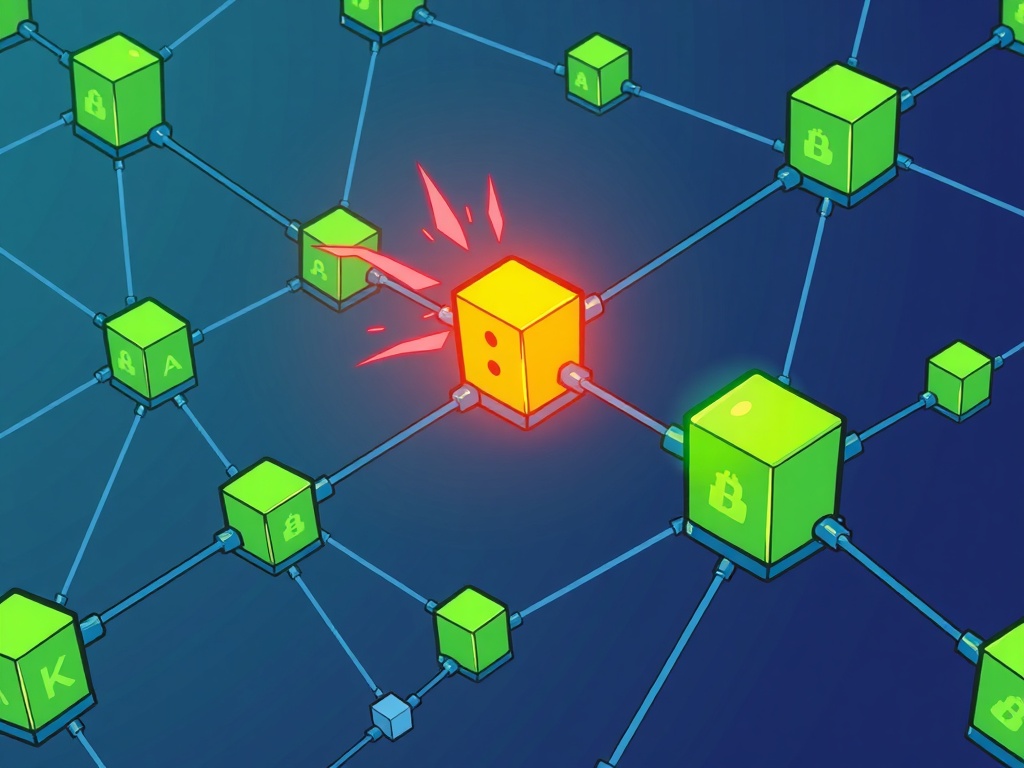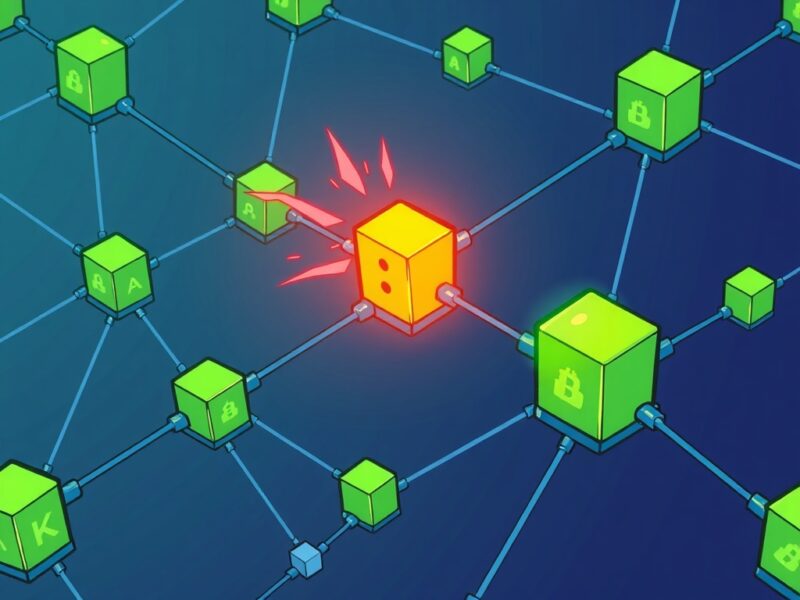BitcoinWorld

Polygon Network Recovers Swiftly After Brief Halt: A Testament to Resilience
In the dynamic world of blockchain technology, where continuous operation is paramount, even the most robust systems can face unexpected challenges. Recently, the Polygon Network, a leading Layer 2 scaling solution for Ethereum, experienced a brief yet notable interruption. This incident, while quickly resolved, highlighted the intricate dance between decentralization, network stability, and the constant need for vigilance in a rapidly evolving digital landscape. What exactly happened, and what does it tell us about the future of scalable blockchain infrastructure?
Understanding the Recent Polygon Network Interruption
On a recent Wednesday, the Polygon Network experienced an unexpected one-hour halt. This was not a complete shutdown of the blockchain, but rather a temporary pause in its progression, akin to hitting a ‘pause’ button on a video playback. The root cause, as identified, was a validator exit that disrupted the network’s Heimdall service. To fully grasp the implications, it’s essential to understand Polygon’s dual-layer architecture:
- Heimdall Layer: This is Polygon’s proof-of-stake layer, responsible for validator management, staking, and checkpointing. It plays a crucial role in ensuring the security and integrity of the network.
- Bor Layer: This is the execution layer, compatible with the Ethereum Virtual Machine (EVM), where transactions are processed and smart contracts are executed.
During the incident, while the Bor layer remained technically ‘live,’ the disruption to Heimdall meant that new blocks could not be proposed or finalized, effectively pausing network progression. This separation of concerns in Polygon’s architecture, while designed for efficiency and scalability, also means that issues in one layer can impact the other’s ability to move forward. The swift identification and resolution of the validator issue allowed the network to resume normal operations within an hour, showcasing the team’s rapid response capabilities.
Why Network Stability Matters for the Polygon Network Ecosystem
For any blockchain, especially one that aims to scale decentralized applications (dApps) and facilitate high-volume transactions, stability is not just a feature; it’s a fundamental requirement. Users, developers, and enterprises rely on consistent uptime and predictable performance. A network halt, no matter how brief, can trigger concerns about:
- User Trust: Frequent or prolonged outages can erode confidence among users who depend on the network for their transactions, DeFi activities, or NFT interactions.
- Developer Confidence: Developers choose blockchain platforms based on their reliability. Instability can deter new projects and lead existing ones to consider alternatives.
- Financial Impact: As seen with the reported 2.5% drop in the POL token price following the news, network disruptions can have immediate financial repercussions for token holders and the broader market.
The Polygon Network has built a reputation for its speed and low transaction costs, attracting a vast ecosystem of dApps, including prominent DeFi protocols and NFT marketplaces. Maintaining an impeccable uptime record is critical for sustaining this growth and competitive edge in the crowded Layer 2 space.
A Look Back: Past Incidents and Lessons Learned
While the recent halt was brief, it wasn’t the first time the Polygon Network has faced operational challenges. The blockchain industry is still relatively nascent, and even established networks encounter growing pains. Polygon has experienced incidents in the past, notably in 2022 and more recently in March 2024. Each of these events, while disruptive, has served as a critical learning opportunity:
| Incident Date | Nature of Disruption | Duration | Key Learning |
|---|---|---|---|
| March 2024 | Heimdall validator exit | ~1 hour | Improved rapid response and validator management protocols. |
| 2022 (Specifics vary) | Various network congestions/minor bugs | Variable | Focus on infrastructure upgrades, scaling solutions, and bug bounties. |
These past experiences have likely contributed to the network’s ability to respond swiftly to the latest incident. Continuous auditing, stress testing, and community feedback are vital for identifying vulnerabilities and enhancing the network’s resilience against future challenges.
The Immediate Impact: POL Token and Market Reaction
Following the news of the halt, the POL token, which is Polygon’s native cryptocurrency, experienced a reported 2.5% drop in value. This immediate market reaction is common in the crypto space, where news, especially concerning network stability, can trigger quick price movements. However, the relatively small percentage drop and the quick recovery of the network suggest that the market largely viewed this as a minor, transient issue rather than a fundamental flaw. It underscores the importance of transparent communication from the Polygon team during such events, as timely updates can mitigate panic and help stabilize market sentiment.
How Does the Polygon Network Ensure Future Resilience?
The incident serves as a reminder that even highly decentralized systems require robust monitoring and incident response protocols. The Polygon Network, like other major blockchains, employs several strategies to enhance its resilience:
- Decentralized Validator Set: A large and diverse set of validators reduces single points of failure. The more validators, the harder it is for one exit to cripple the network.
- Monitoring and Alerting Systems: Sophisticated systems are in place to detect anomalies and alert core teams to potential issues in real-time.
- Community Involvement: The open-source nature of blockchain allows for community audits and bug bounty programs, leveraging collective intelligence to identify and fix vulnerabilities.
- Continuous Upgrades: Regular protocol upgrades, such as the ongoing transition to Polygon 2.0 and the implementation of ZK-Rollups, aim to improve scalability, security, and overall network robustness. These upgrades are designed to make the network more resistant to various types of attacks and operational hiccups.
The commitment to these ongoing improvements is a key factor in the Polygon Network‘s ability to bounce back from challenges and maintain its position as a critical player in the blockchain ecosystem.
Actionable Insights for Users and Developers
For those interacting with or building on the Polygon Network, the recent event offers valuable insights:
- Stay Informed: Follow official Polygon channels (Twitter, Discord, blog) for real-time updates during network events. Accurate information helps avoid panic and misinformation.
- Understand Network Architecture: For developers, a deeper understanding of Heimdall and Bor layers can help in designing more resilient dApps that can gracefully handle brief network pauses.
- Diversify Risk: For users with significant assets, consider diversifying across different Layer 2 solutions or maintaining a portion on Layer 1 Ethereum, although this comes with higher gas fees.
- Participate in Governance (if applicable): For validators or large token holders, participating in governance can help shape the network’s future resilience strategies.
Concluding Thoughts: A Stronger Polygon Network Emerges
The one-hour halt on the Polygon Network, while a temporary inconvenience, ultimately serves as a testament to the network’s inherent resilience and the efficacy of its operational teams. In a technology as complex and rapidly evolving as blockchain, occasional hiccups are almost inevitable. What truly defines a robust system is not the absence of issues, but the speed and effectiveness of its recovery. Polygon’s swift resolution, coupled with its ongoing commitment to decentralization, security, and scalability through initiatives like Polygon 2.0, reinforces its position as a critical infrastructure layer for the decentralized future. The incident was a brief blip, but the lessons learned will undoubtedly contribute to a stronger, more reliable Polygon Network moving forward.
Frequently Asked Questions (FAQs)
Q1: What caused the recent Polygon Network halt?
A1: The recent halt was caused by a validator exit that disrupted the network’s Heimdall service, temporarily pausing the progression of new blocks.
Q2: Was the entire Polygon Network shut down during the incident?
A2: No, the chain remained live, but its progression was paused. The Bor execution layer was operational, but new blocks could not be finalized due to the Heimdall disruption.
Q3: How long did the Polygon Network halt last?
A3: The network halt lasted for approximately one hour before normal operations resumed.
Q4: How did the POL token price react to the news?
A4: According to reports, the POL token experienced a 2.5% drop in value following the news of the halt, but the market reaction was relatively contained given the swift resolution.
Q5: What is Polygon doing to prevent future halts?
A5: Polygon continuously works on enhancing its network resilience through a decentralized validator set, advanced monitoring systems, community involvement, and ongoing protocol upgrades like Polygon 2.0, which includes a focus on ZK-Rollups for improved security and scalability.
Q6: Is Polygon Network reliable for dApps and transactions?
A6: Despite occasional brief interruptions, the Polygon Network has demonstrated strong resilience and rapid recovery capabilities. Its commitment to continuous improvement and robust architecture makes it a highly reliable and popular choice for a wide range of dApps and high-volume transactions.
Did you find this article insightful? Share it with your friends and fellow crypto enthusiasts on social media to spread awareness about the resilience of the Polygon Network!
To learn more about the latest crypto market trends, explore our article on key developments shaping Polygon network’s future.
This post Polygon Network Recovers Swiftly After Brief Halt: A Testament to Resilience first appeared on BitcoinWorld and is written by Editorial Team





